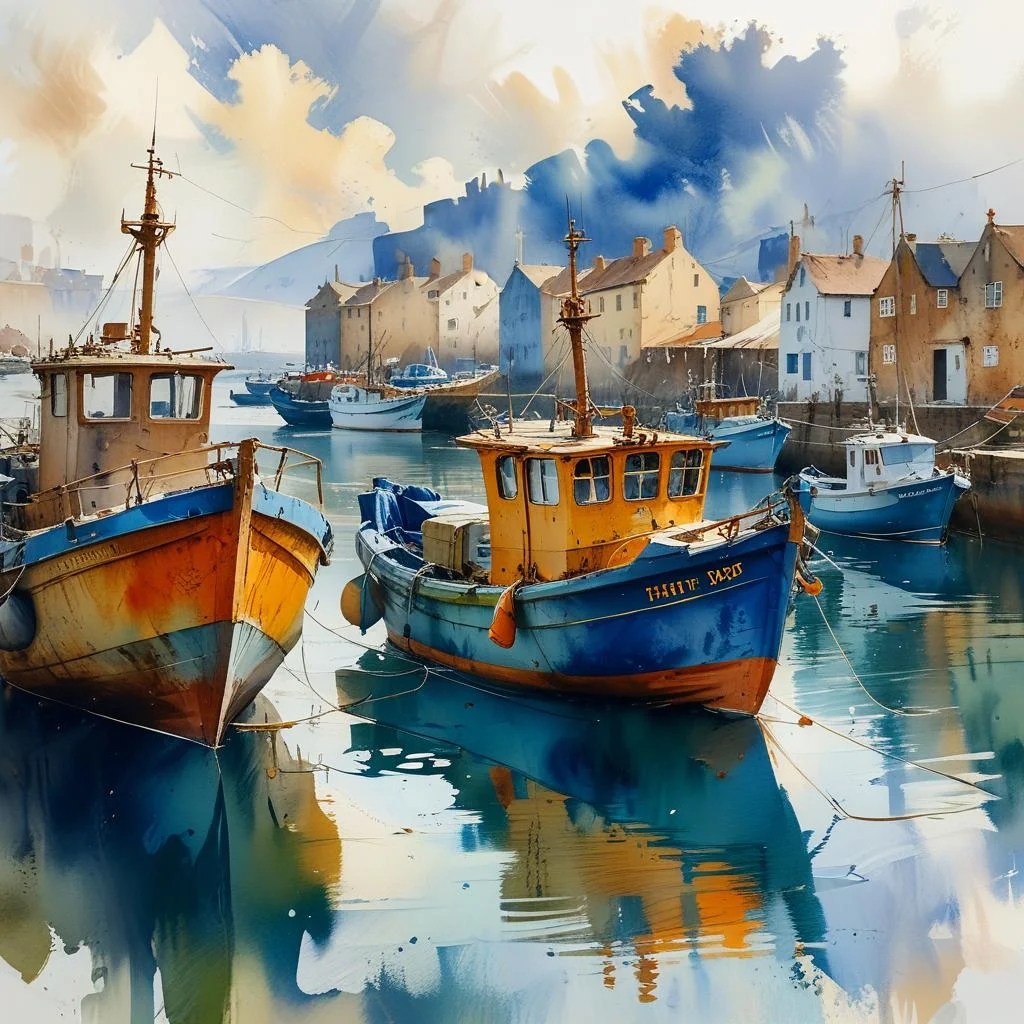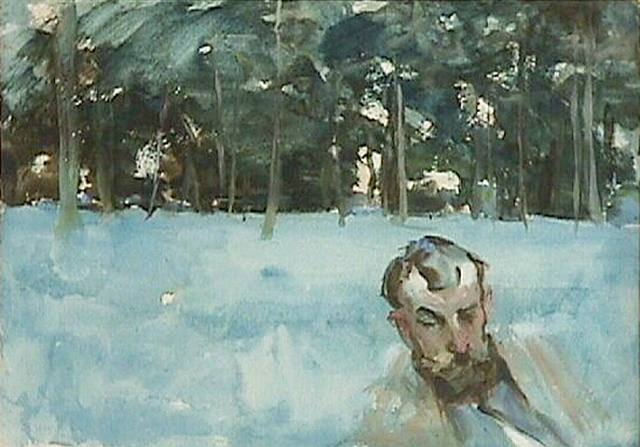Paul Nash (1889-1946) stands as one of the most important British artists of the 20th century, a revolutionary figure who transformed landscape painting through his unique blend of Modernism and Surrealism. As an official war artist in both World Wars, Nash witnessed humanity’s darkest moments and channeled these experiences into powerful, haunting artworks that forever changed how we see the English countryside. His ability to merge deep love for nature with cutting-edge artistic techniques made him a bridge between traditional British art and the bold new movements sweeping across Europe.
Key Points Summary
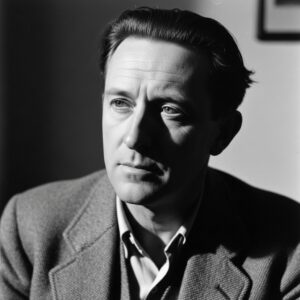
- War transformed Nash’s art: His experiences as a WWI and WWII war artist shifted his style from romantic landscapes to powerful, abstract visions
- Pioneer of British Surrealism: Co-founded “Unit One” and helped organize the 1936 International Surrealist Exhibition in London
- Iconic masterpieces: Created unforgettable works like “We Are Making a New World” and “Totes Meer (Dead Sea)”
- Lasting influence: Brought Modernism to conservative British art circles and continues inspiring artists today
The Early Years: From Countryside Dreams to Artistic Vision
Born in London but raised in the gentle rolling hills of Buckinghamshire, Nash developed what can only be described as a mystical connection to the English landscape. Like his contemporary Eric Ravilious, Nash found inspiration in the peaceful countryside that surrounded his childhood home.
His early paintings reflected this deep love for nature, showing clear influences from Romantic artists like William Blake and Samuel Palmer. These works featured soft, dreamy depictions of trees, hills, and skies that seemed to glow with an inner light. The young Nash painted landscapes that felt more like spiritual experiences than simple nature studies.
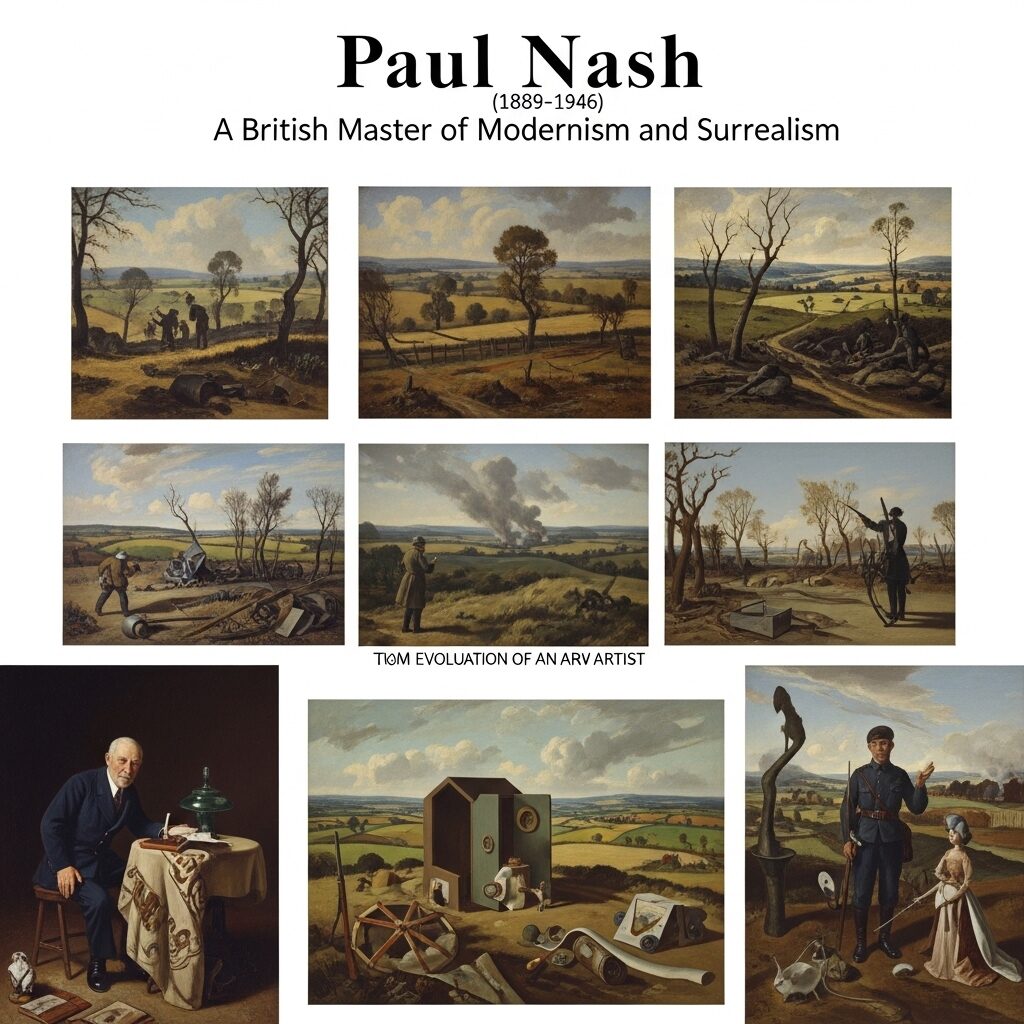
However, this peaceful period would not last. The outbreak of World War I in 1914 would shatter Nash’s pastoral dreams and transform him into one of Britain’s most powerful war artists.
World War I: When Art Meets Horror
Nash’s service on the Western Front exposed him to scenes of unimaginable destruction. The gentle countryside he had lovingly painted was replaced by mud-filled trenches, shattered trees, and landscapes scarred beyond recognition. This traumatic experience fundamentally changed not just Nash as a person, but Nash as an artist.
His war paintings from this period are not mere historical records – they are emotional earthquakes captured on canvas. Using increasingly abstract techniques, Nash showed the world what modern warfare really looked like. His brushstrokes became sharper, his colors more muted, and his compositions more dramatic.
“We Are Making a New World” (1918)
Perhaps no single painting captures the horror and irony of World War I better than Nash’s masterpiece “We Are Making a New World.” The title itself drips with bitter sarcasm – this “new world” is a wasteland of mud, craters, and skeletal tree stumps reaching toward a cold, pale sun.

The painting’s power lies in its simplicity. There are no soldiers, no battles, no dramatic action – just the aftermath. The land itself has become the casualty, and Nash forces us to confront what “progress” and “civilization” actually created.
The 1930s: Embracing Surrealism
After the war, Nash couldn’t simply return to his earlier romantic style. The world had changed, and so had he. In the 1930s, he became fascinated with Surrealism in Britain, helping to introduce this revolutionary European art movement to often-conservative British audiences.
Nash co-founded an influential group called “Unit One” and played a key role in organizing the 1936 International Surrealist Exhibition in London. This exhibition shocked and delighted visitors, introducing them to the strange, dreamlike world of Surrealist art.
“Landscape from a Dream” (1936-38)
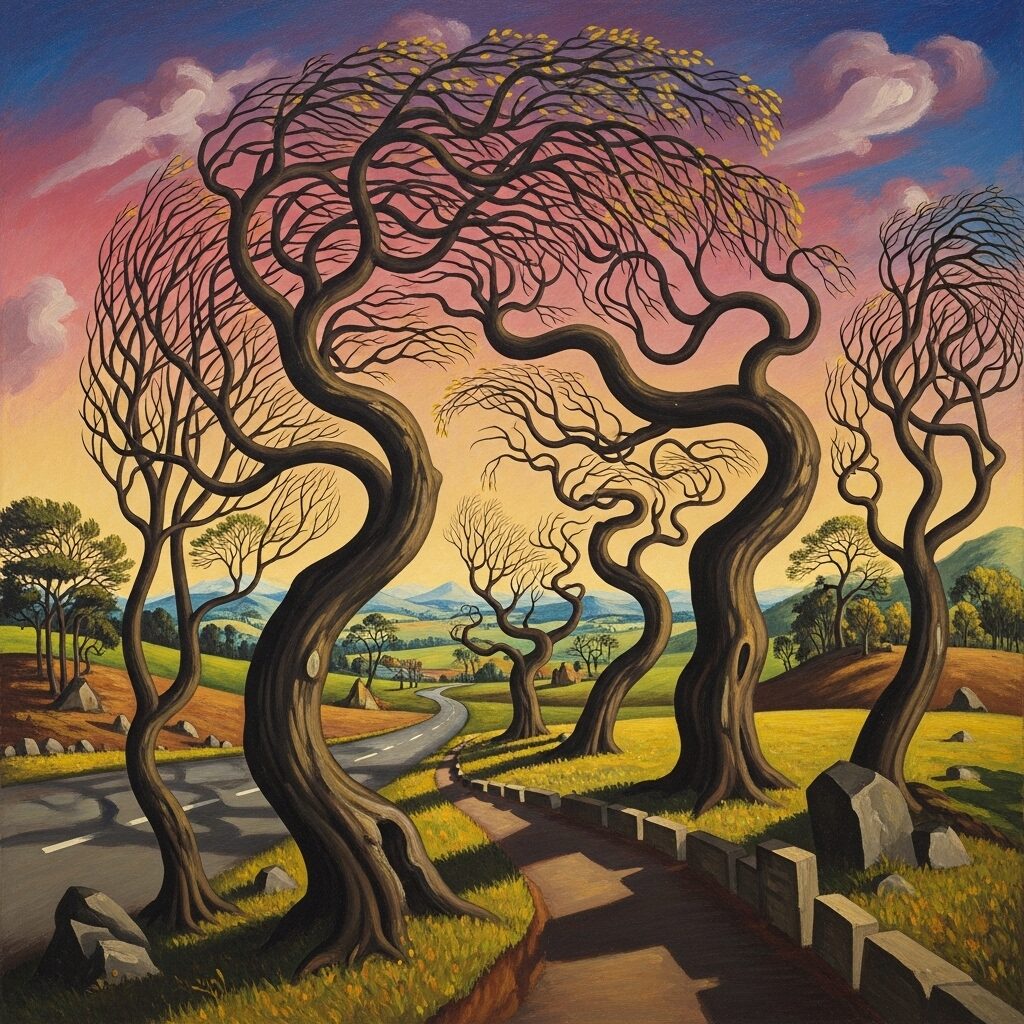
This painting perfectly demonstrates Nash’s surrealist period. At first glance, it appears to be a peaceful coastal scene with chalk cliffs in the distance. But look closer, and you’ll notice something strange – a large, ornate mirror stands in the landscape, but instead of reflecting the scene around it, it shows a completely different sky. A hawk flies overhead, observing this impossible situation.
The painting invites us into a world where logic doesn’t apply, where our subconscious minds create the rules. It’s both beautiful and unsettling – exactly what Nash intended.

transforms a scrapyard of downed German planes into a ghostly, metallic sea.
World War II: The Return of the War Artist
When World War II began, Nash once again took up his role as an official war artist. But this time, his approach was different. He had spent the intervening years developing his surrealist techniques, and now he applied these skills to depicting the new conflict.
“Totes Meer (Dead Sea)” (1940-41)
This haunting masterpiece shows Nash at the peak of his artistic powers. The painting depicts a vast graveyard of wrecked German aircraft, but Nash transforms this scene of destruction into something that resembles a metallic ocean under cold moonlight.
The twisted wings and fuselages of the destroyed planes create waves and currents, turning the machinery of war into a surreal seascape. It’s a powerful meditation on death, defeat, and the strange beauty that can emerge from destruction. This work perfectly illustrates how WWII influenced post-war artists.
Paul Nash’s Artistic Techniques and Style
| Period | Style Characteristics | Key Influences | Notable Works |
|---|---|---|---|
| Early Career (1900s-1914) | Romantic landscapes, soft colors, mystical quality | William Blake, Samuel Palmer | Early Buckinghamshire landscapes |
| WWI Period (1914-1918) | Stark, abstract, emotionally powerful | Direct war experience | “We Are Making a New World” |
| Interwar Period (1920s-1930s) | Surrealist, dreamlike, mysterious | Giorgio de Chirico, European Surrealism | “Landscape from a Dream” |
| WWII Period (1939-1946) | Mature synthesis of realism and surrealism | Previous war experience, artistic maturity | “Totes Meer (Dead Sea)” |
Nash’s Role in British Art History
Nash’s importance goes far beyond his individual paintings. He served as a crucial bridge between the conservative British art establishment and the revolutionary movements emerging from Europe. Through his work with “Unit One” and his involvement in exhibitions, Nash helped introduce British audiences to concepts and techniques that would reshape their understanding of what art could be.
His approach to the English landscape was particularly revolutionary. Rather than simply depicting pretty countryside scenes, Nash showed how landscapes could express complex emotions, tell stories, and explore the deepest aspects of human experience.
“I am no longer an artist interested and curious, I am a messenger who will bring back word from the men who are fighting to those who want the war to go on forever. Feeble, inarticulate, will be my message, but it will have a bitter truth, and may it burn their lousy souls.”
Paul Nash, 1917
Legacy and Continuing Influence
Today, Paul Nash is recognized as one of the most influential artists of the 20th century. His work continues to inspire contemporary artists who are drawn to his unique ability to find beauty in destruction and meaning in chaos.
Nash’s influence extends beyond the art world. His war paintings have become some of the most powerful anti-war statements ever created, helping us understand the true cost of conflict. His surrealist works continue to challenge our perceptions and invite us to explore the mysterious connections between our conscious and unconscious minds.
Understanding Nash’s work helps us appreciate the broader context of 20th-century art movements and how individual artists responded to the dramatic changes of their time. Nash showed that art doesn’t have to be separate from life’s struggles – it can engage directly with history’s most challenging moments and emerge with profound insights about the human condition.
Paul Nash’s legacy as a master of British Modernism and Surrealism remains as powerful today as it was during his lifetime, reminding us that great art can transform tragedy into beauty, chaos into meaning, and personal experience into universal truth.
Frequently Asked Questions
What made Paul Nash’s war art so different from other war artists? Nash didn’t focus on battles or heroic soldiers. Instead, he painted the landscape itself as the victim of war, creating powerful emotional statements about the true cost of conflict.
How did Paul Nash influence British Surrealism? Nash co-founded the “Unit One” group and helped organize the 1936 International Surrealist Exhibition in London, introducing British audiences to European Surrealist techniques and concepts.
What is Paul Nash’s most famous painting? “We Are Making a New World” (1918) is widely considered his masterpiece, depicting a devastated WWI battlefield under a cold sunrise with bitter irony.
Why are Paul Nash’s landscapes considered revolutionary? Nash transformed landscape painting from simple nature scenes into complex explorations of psychology, emotion, and human experience, particularly the impact of war and modern life.
How did Paul Nash’s style change over his career? Nash evolved from romantic, nature-loving landscapes to stark war imagery, then embraced Surrealism in the 1930s before developing a mature synthesis of realism and surrealism during WWII.

